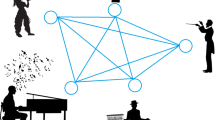Abstract
We propose a technique to make a robot execute free and solitary dance movements on music, in a manner which simulates the dynamic alternations between synchronisation and autonomy typically observed in human behaviour. In contrast with previous approaches, we preprogram neither the dance patterns nor their alternation, but rather build in basic dynamics in the robot, and let the behaviour emerge in a seemingly autonomous manner. The robot motor commands are generated in real-time by converting the output of a neural network processing a sequence of pulses corresponding to the beats of the music being danced to. The spiking behaviour of individual neurons is controlled by a biologically-inspired model (FitzHugh-Nagumo). Under appropriate parameters, the network generates chaotic itinerant behaviour among low-dimensional local attractors. A robot controlled this way exhibits a variety of motion styles, some being periodic and strongly coupled to the musical rhythm and others being more independent, as well as spontaneous jumps from one style of motion to the next. The resulting behaviour is completely deterministic (as the solution of a non-linear dynamical system), adaptive to the music being played, and believed to be an interesting compromise between synchronisation and autonomy.
Preview
Unable to display preview. Download preview PDF.
Similar content being viewed by others
References
Bradley, E., Stuart, J.: Using chaos to generate variations on movement sequences. Chaos 8, 800–807 (1998)
Fitzhugh, R.: Impulses and psychologial states in theoretical models of nerve membrane. BioPhys. Journal 1(1), 445–466 (1961)
Godoy, R., Haga, E., Jensenius, A.R.: Exploring music-related gestures by sound-tracing. - a preliminary study. In: 2nd ConGAS International Symposium on Gesture Interfaces for Multimedia Systems, Leeds (UK) (2006)
Goto, M.: An audio-based real-time beat tracking system for music with or without drum-sounds. Journal of New Music Research 30(2), 159–171 (2001)
Gouyon, F., Klapuri, A., Dixon, S., Alonso, M., Tzanetakis, G., Uhle, C., Cano, P.: An experimental comparison of audio tempo induction algorithms. IEEE Transactions on Audio, Speech and Language Processing 14(5), 1832–1844 (2006)
Ikeda, K., Otsuka, K., Matsumoto, K.: Maxwell bloch turbulence. Prog. Theor. Phys (supplement) 99, 295–324 (1989)
Ikegami, T.: Simulating active perception and mental imagery with embodied chaotic itinerancy. Journal of Consciousness Studies 14(7), 111–125 (2007)
Kaneko, K., Tsuda, I.: Chaotic itinerancy. Chaos 13(3), 926–936 (2003)
Kay, L.: A challenge to chaotic itinerancy from brain dynamics. Chaos 13(3), 1057–1066 (2003)
Kostova, T., Ravindran, R., Schonbek, M.: Fitzhugh nagumo revisited: Types of bifurcations, periodical forcing and stability regions by a lyapunov functional. International Journal of Bifurcation and Chaos 14(3), 913–925 (2004)
Kosuge, K., Hayashi, T., Hirata, Y., Tobiyama, R.: Dance partner robot -ms dancerr-. In: Proceedings of the IEEE/RSJ International Conference on Intelligent Robots and Systems (2003)
Michalowski, M.P., Sabanovic, S., Kozima, H.: A dancing robot for rhythmic social interaction. In: Proceedings of HRI (2007)
Nakazawa, A., Nakaoka, S., Ikeuchi, K.: Imitating human dance motions through motion structure analysis. In: Proceedings of International Conference on Intelligent Robots and Systems (2002)
Pachet, F.: On the Design of Flow Machines. In: The Future of Learning, IOS Press, Amsterdam (2004)
Press, W., Flannery, B., Teukolsky, S., Vetterling, W.: Numerical Recipes, The Art of Scientific Computing. Cambridge University Press, Cambridge (1986)
Scheirer, E.: Tempo and beat analysis of acoustic musical signals. Journal of the Acoustic Society of America 103(1), 588–601 (1998)
Takahashi, H., Horibe, N., Ikegami, T., Shimada, M.: Analyzing house fly’s exploration behavior with ar methods. Journal of the Japanese Phycis Society (submitted, 2007)
Tanaka, F., Suzuki, H.: Dance interaction with qrio: A case study for non-boring interaction by using an entrainment ensemble model. In: Proceedings of the 2004 IEEE International Workshop on Robot and Human Interactive Communication (2004)
Wanderley, M.M., Vines, B., Middleton, N., McKay, C., Hatch, W.: The musical significance of clarinetists’ ancillary gestures: An exploration of the field. Journal of New Music Research 34(1), 97–113 (2005)
Author information
Authors and Affiliations
Editor information
Rights and permissions
Copyright information
© 2008 Springer-Verlag Berlin Heidelberg
About this paper
Cite this paper
Aucouturier, JJ., Ogai, Y., Ikegami, T. (2008). Making a Robot Dance to Music Using Chaotic Itinerancy in a Network of FitzHugh-Nagumo Neurons. In: Ishikawa, M., Doya, K., Miyamoto, H., Yamakawa, T. (eds) Neural Information Processing. ICONIP 2007. Lecture Notes in Computer Science, vol 4985. Springer, Berlin, Heidelberg. https://doi.org/10.1007/978-3-540-69162-4_67
Download citation
DOI: https://doi.org/10.1007/978-3-540-69162-4_67
Publisher Name: Springer, Berlin, Heidelberg
Print ISBN: 978-3-540-69159-4
Online ISBN: 978-3-540-69162-4
eBook Packages: Computer ScienceComputer Science (R0)




